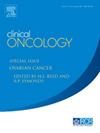Third Course of Radical Intent Conformal Radiation in Patients with Primary Brain Tumors
IF 3.2
3区 医学
Q2 ONCOLOGY
引用次数: 0
Abstract
Aims
Reirradiation is increasingly considered in patients with recurrent primary brain tumours. However, second course of radical reirradiation (RT2) or third course of radiation (RT3) delivering higher doses is uncommon. The current study was undertaken to report the clinical outcomes after the third course of radical radiation.
Materials and methods
The patients undergoing three courses of cranial radiation were obtained from the radiation oncology database. The clinical and treatment details were obtained by reviewing electronic medical records and radiation charts and plans when available. Treatment outcomes, including disease status and radionecrosis, were assessed by reviewing imaging. Analysis was done using descriptive statistics and survival outcomes using Kaplan–Meier survival plots.
Results
Eight patients were identified between 2015 and 2023 treated with a third course of radiotherapy (second reirradiation). Histopathology included ependymoma in seven and glioblastoma in one patient. The median age during first radiation was 13.5 years (range: 4–31 years) with interquartile range (IQR) of 7–26 years, and during RT3 was 22 years (range: 9–43 years, IQR: 14–32 years). The median doses at RT1, RT2, and RT3 were 59.4 Gy (IQR: 54.80–60 Gy), 54 Gy (IQR: 51.3–54.0 Gy), and 50.4 Gy (IQR: 50.0–50.4 Gy), respectively. The median interval between RT1 and RT2 was 37 months (IQR: 29–63 months), RT2 and RT3 was 39 months (IQR: 25–67 months). The median cumulative EQD2 from three courses was (IQR: 148.7–159.1 ). After 3rd course, the median follow-up was 25 months (IQR: 15–37 months) with a 2-year overall survival of 85%. One patient had developed symptomatic radionecrosis 14 months after RT3 and was treated with bevacizumab.
Conclusion
The third course of radical dose of radiation can be considered a reasonable approach for tumours with local recurrence after a reasonable interval of at least two years between each course, allowing for tissue recovery.
原发性脑肿瘤患者根治性适形放射治疗的第三疗程
目的复发性原发性脑肿瘤患者越来越多地考虑再放射治疗。然而,第二次放射治疗(RT2)或第三次放射治疗(RT3)给予更高剂量是罕见的。本研究旨在报告第三疗程根治性放疗后的临床结果。材料与方法从放射肿瘤学数据库中获取3个疗程的颅脑放疗患者。临床和治疗细节是通过审查电子病历和放射图和计划获得的。通过影像学检查评估治疗结果,包括疾病状态和放射性坏死。使用描述性统计进行分析,使用Kaplan-Meier生存图进行生存结果分析。结果2015年至2023年间,8例患者接受了第三次放射治疗(第二次再放射)。组织病理学包括7例室管膜瘤和1例胶质母细胞瘤。第一次放疗时的中位年龄为13.5岁(范围4-31岁),四分位数间距(IQR)为7-26岁,放射治疗期的中位年龄为22岁(范围9-43岁,IQR为14-32岁)。RT1、RT2和RT3的中位剂量分别为59.4 Gy (IQR: 54.80-60 Gy)、54 Gy (IQR: 51.3-54.0 Gy)和50.4 Gy (IQR: 50.0-50.4 Gy)。RT1和RT2的中位间隔为37个月(IQR: 29-63个月),RT2和RT3的中位间隔为39个月(IQR: 25-67个月)。三个疗程的累积EQD2中位数为153Gy2 (IQR: 148.7-159.1 Gy2)。第三个疗程后,中位随访时间为25个月(IQR: 15-37个月),2年总生存率为85%。1例患者在RT3治疗14个月后出现症状性放射性坏死,并接受贝伐单抗治疗。结论对于局部复发的肿瘤,每次放射治疗的合理间隔至少为2年,允许组织恢复,第三疗程放射治疗是一种合理的方法。
本文章由计算机程序翻译,如有差异,请以英文原文为准。
求助全文
约1分钟内获得全文
求助全文
来源期刊

Clinical oncology
医学-肿瘤学
CiteScore
5.20
自引率
8.80%
发文量
332
审稿时长
40 days
期刊介绍:
Clinical Oncology is an International cancer journal covering all aspects of the clinical management of cancer patients, reflecting a multidisciplinary approach to therapy. Papers, editorials and reviews are published on all types of malignant disease embracing, pathology, diagnosis and treatment, including radiotherapy, chemotherapy, surgery, combined modality treatment and palliative care. Research and review papers covering epidemiology, radiobiology, radiation physics, tumour biology, and immunology are also published, together with letters to the editor, case reports and book reviews.
 求助内容:
求助内容: 应助结果提醒方式:
应助结果提醒方式:


